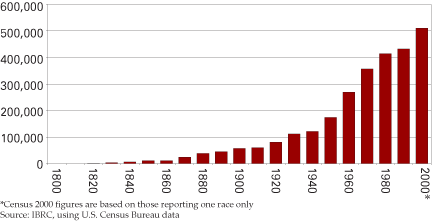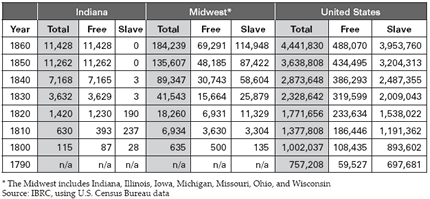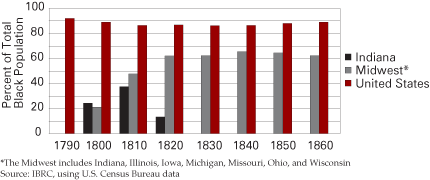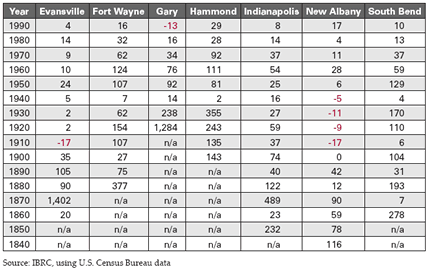Black and White in Indiana
Indiana Business Research Center, Kelley School of Business, Indiana University
Statistics and emotions do not generally coincide, but the innocuous looking documents titled working papers numbers 56 and 76 from the U.S. Census Bureau contain a chilling reminder of the early decades in our national and state history. The plain blue covers and inexpensive binding display lengthy titles generally reflective of research tomes, Historical Census Statistics on Population Totals by Race, 1790 to 1990, and by Hispanic Origin, 1790 to 1990.
The working papers, written and compiled by one of the Census Bureau’s talented and knowledgeable statisticians, Campbell Gibson, provide us with two important historical documents.(1,2) These documents comprise a numerical history lesson, documenting the changing structure of race in our states and larger cities since the first census of the United States was conducted, as constitutionally mandated, in 1790.
A Compelling Reminder of American History
In 21st century America, we are far removed from the ways of life of the founding Americans. But one look at a simple table reveals how people living in the United States of America were counted by federal officials. It also serves as an uncomforting reminder of the ways we were then able to define human beings as being free or slave and in later decades, attempting to numerically define how black a person was if their lineage was of mixed races. While Indiana has offered hope to African Americans, some believe that the latest census in 2000 harkened back to those times by including the new option for checking all races that apply, again bringing up the question of how much of a race someone is with a numbing array of 164 racial combinations being possible.
As we can see in Table 1, the black or African American population prior to the Civil War was counted specifically by census takers in three ways. First, it was determined if the persons were black (or negro in the terminology of the times). Then, those persons were determined to be either free or slave. It is important to note here that such questions were not asked of the individuals and this is true even today. Rather, the question was posed to the head of the household. The head of the household told the census taker how many people were part of his household (since generally it was a male to whom the census taker turned for responses) and to indicate what their status was—wife, child, other relation, or slave. In the case of so-termed free blacks, the head of their household was interviewed by the census taker, unless they were workers living on a householder’s land.
Table 1
Black Population Prior to the Civil War, as Counted by the Census
Click for larger image
Defining Black
The American decennial census has long been a mirror of the society it counts and since race questions have changed with almost every census during our history, we can see the way America continues to grapple with the issue of race.
In the early censuses of 1790 to 1840, the term negro was the only racial identifier for blacks, with the concept of being free or slave as an additional characteristic. However, in later censuses, as Gibson writes, “enumerators were instructed to identify Mulattoes (and Quadroons and Octoroons in 1890) among the Black population.” Since, as the author further notes, such delineations were of dubious accuracy, they were not included in the reports cited here. Indeed, over much of this country’s history of defining race, the issue of who is black became a mathematical formula, once based on the notion that each person consists of 128 parts and the combination of white and black in those parts would determine how much a negro someone was and ergo, such terminology as mulatto or quadroon.
Black and White Population Trends in Indiana
While Indiana has been home to African Americans since the time of the Indiana territory (which under the 1787 Northwest Territory Ordinance was free), the state had few blacks who were counted as slaves; by 1830 and 1840, only three such individuals were counted in the entire state. Indiana historians indicate that many black pioneers settling in Indiana were farmers from Virginia and North Carolina, likely fleeing subjugation in those states.(3) By the time of the Civil War, no slaves were enumerated in the Hoosier State. The same cannot be said for the United States as a whole, in which the vast majority of blacks were slaves—nearly four million were counted just prior to the war. Between 1800 and 1860, a majority of blacks were also enslaved in the Midwestern states (see Figure 1).
Figure 1
Slave Population as a Percent of the Total Black Population Prior to the
Civil War
Click for larger image
However, lest we believe Indiana was immune to these issues, the Indiana Constitution of 1851 had an exclusionary clause (Article 13) that restricted blacks from settling in Indiana (invalidated in 1866).(4) We see direct evidence of this in the census counts. The black population in Indiana was more than doubling each decade between 1820 and 1850 by the addition of at least 2,000 persons. Suddenly, between 1850 and 1860, there was growth of only 200 black persons.
Post-Civil War Trends
Indiana’s black population growth was slow but steady during the decades after the war. African Americans continued to settle in Indiana throughout the 1900s, with growth rates in percentage terms consistently higher than those of whites (see Figure 2). The exception was the time period between 1900 and 1910, when the growth in population was 7.4 percent for whites and only 4.9 percent for blacks.
Figure 2
Percent Change in Black and White Populations in Indiana, 1900 to 2000
Click for larger image
By 1930, the count of African Americans moved past the 100,000 person mark, and by 1960, there were 269,000 counted as residents. This 1960 count nearly doubled by Census 2000, to more than 500,000 blacks (see Figure 3).
Figure 3
Indiana’s Black Population, 1800 to 2000

Mostly Urban
While early African American settlers were predominantly farmers, the greatest population growth of this group over time was in the urban areas of the state. Between censuses, the percentage growth of seven of Indiana’s largest cities and towns (as included in the Census Bureau publication cited) was often considerable.
Some examples include the 1,402 percent increase in the black population of Evansville between 1860 and 1870 and a 1,284 percent increase in the black population of the new city of Gary between 1910 and 1920, driven largely by the new steel mills in that part of the state (see Table 2). New Albany, on the other hand, was the only one of these seven large cities to lose black population prior to the 1990 Census. Between 1910 and 1940, a period of significant migration of blacks to more northern industrial areas, New Albany lost hundreds of blacks each year, although its African American population has been relatively consistent with between 1,200 and 2,200 people. Indianapolis has the largest African American population in the state, with more than 200,000 counted in Census 2000.
Table 2
Percent Change in Black Population, Early 1800s to 1990
Click for larger image
Conclusion
Census data help us to quantify our population and are reflective of societal trends in our country, states, and communities. However, while the numbers provide us with indications of the effects of our customs and laws as enforced at the time, we must explore further into our own experiences and the research of historians to gain deeper insights.
Notes
- Campbell Gibson and Kay Jung, Historical Census Statistics on Population Totals by Race, 1790 to 1990, and by Hispanic Origin, 1970 to 1990, for Large Cities and Other Urban Places in the United States, Working Paper No. 76, prepared by the Population Division, U.S. Census Bureau (Washington, D.C., February 2005). Available at www.census.gov/population/www/documentation/twps0076/twps0076.html.
- Campbell Gibson and Kay Jung, Historical Census Statistics on Population Totals by Race, 1790 to 1990, and by Hispanic Origin, 1970 to 1990, for the United States, Regions, Divisions, and States, Working Paper No. 56, prepared by the Population Division, U. S. Census Bureau (Washington, D.C., September 2002).
- Indiana Historical Bureau, Black Settlers in Indiana (1993). Available at http://www.statelib.lib.in.us/www/ihb/publications/7015.pdf
- The Constitution of 1851 (original). Available at www.statelib.lib.in.us/www/ihb/resources/constarticle13.html.







